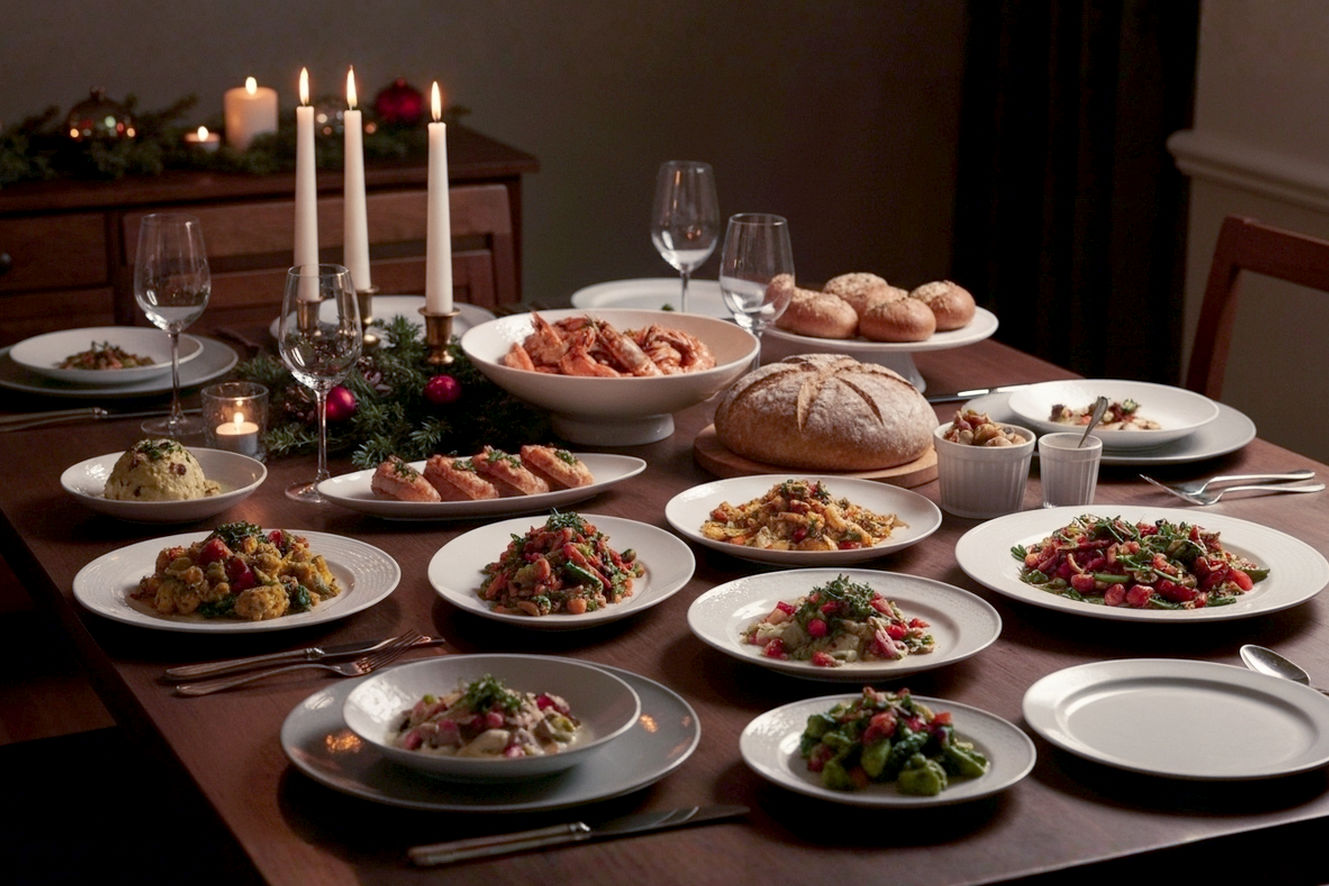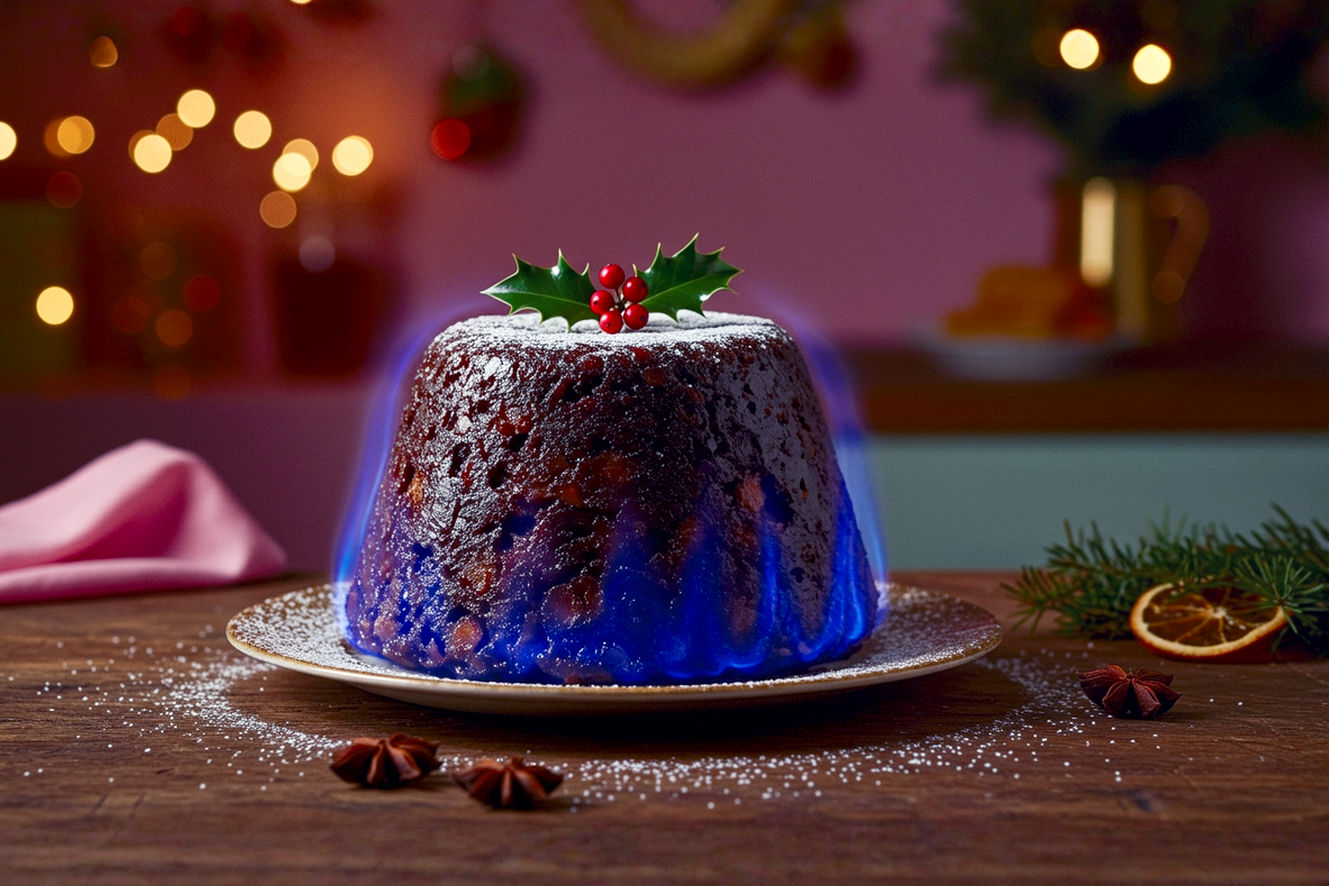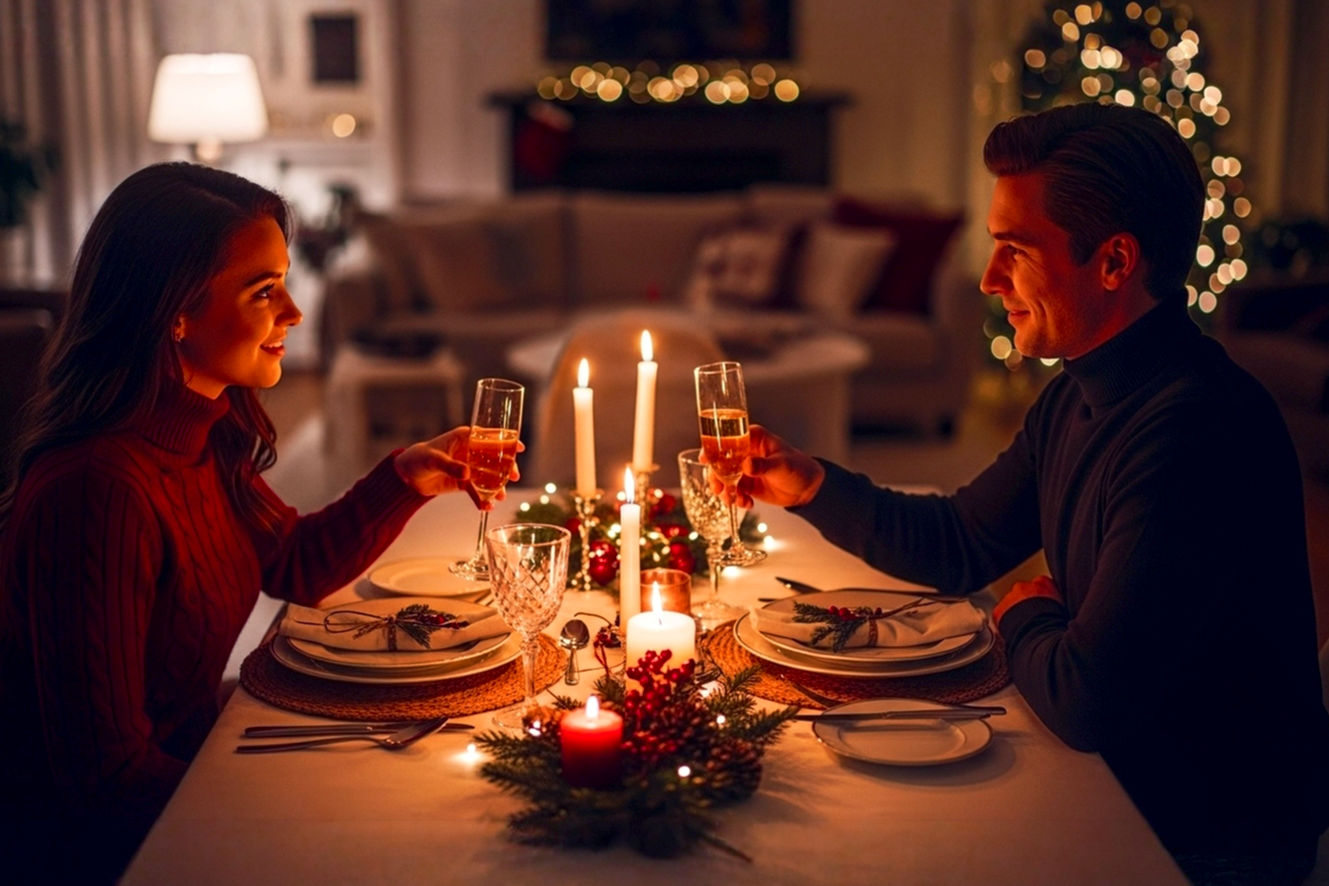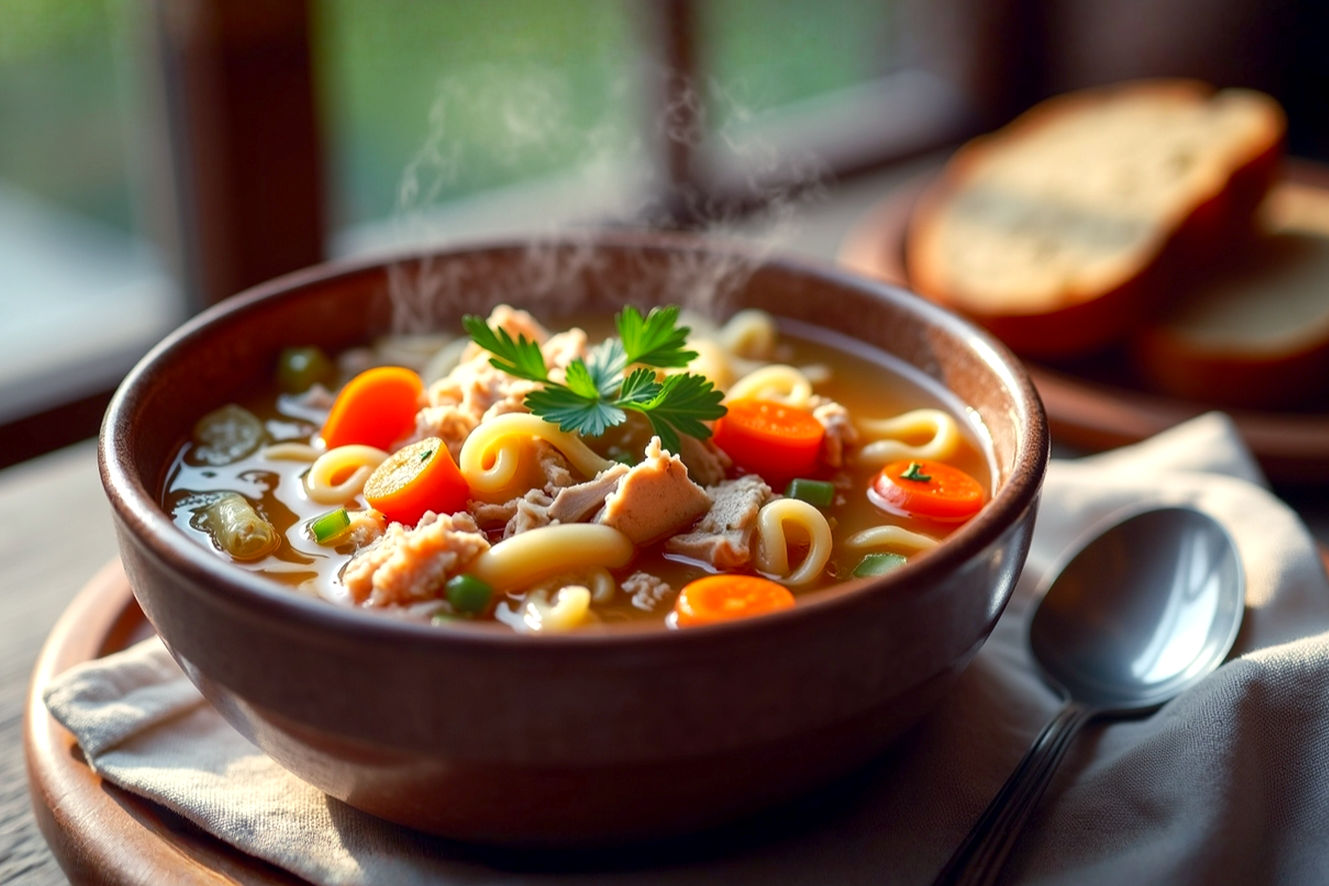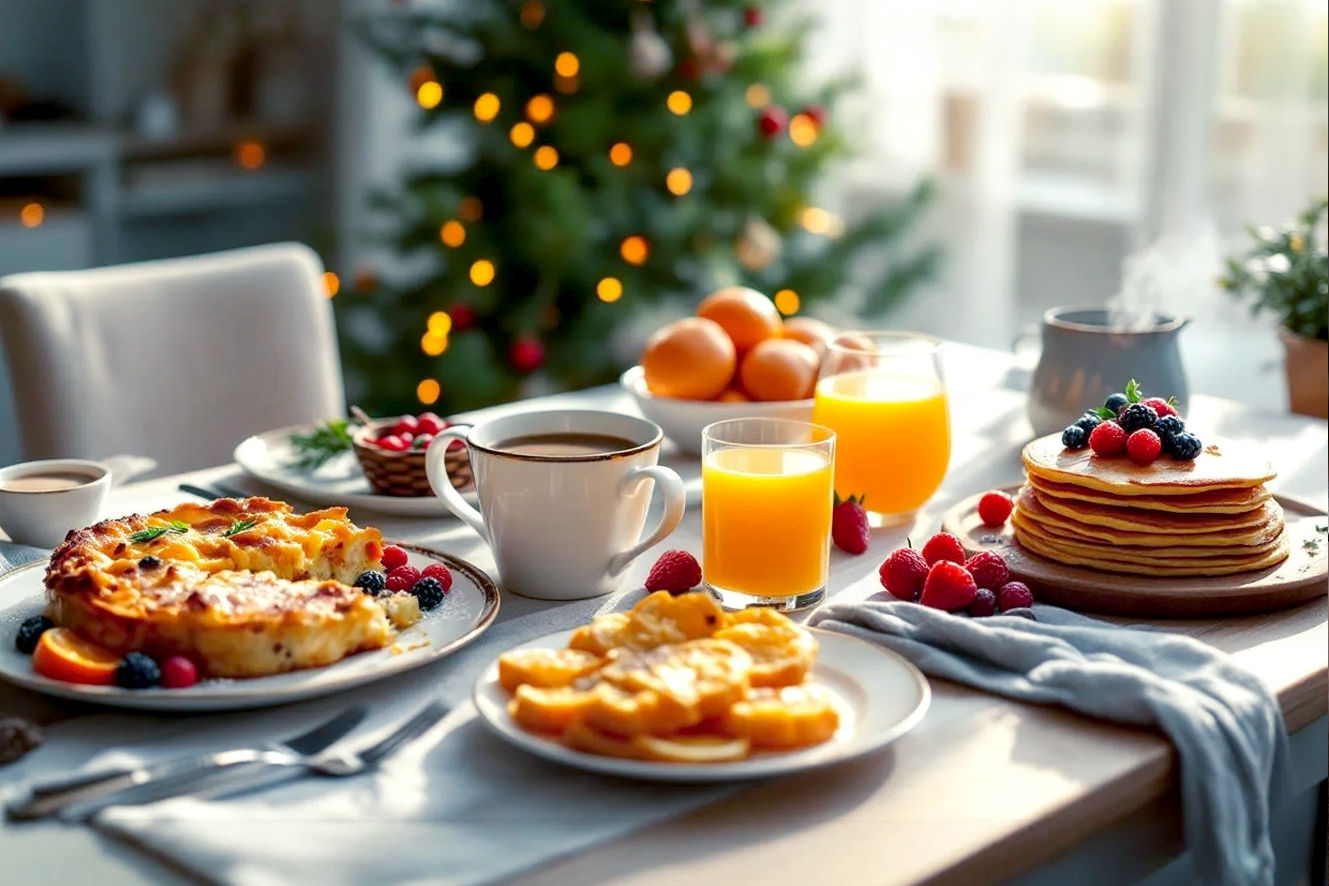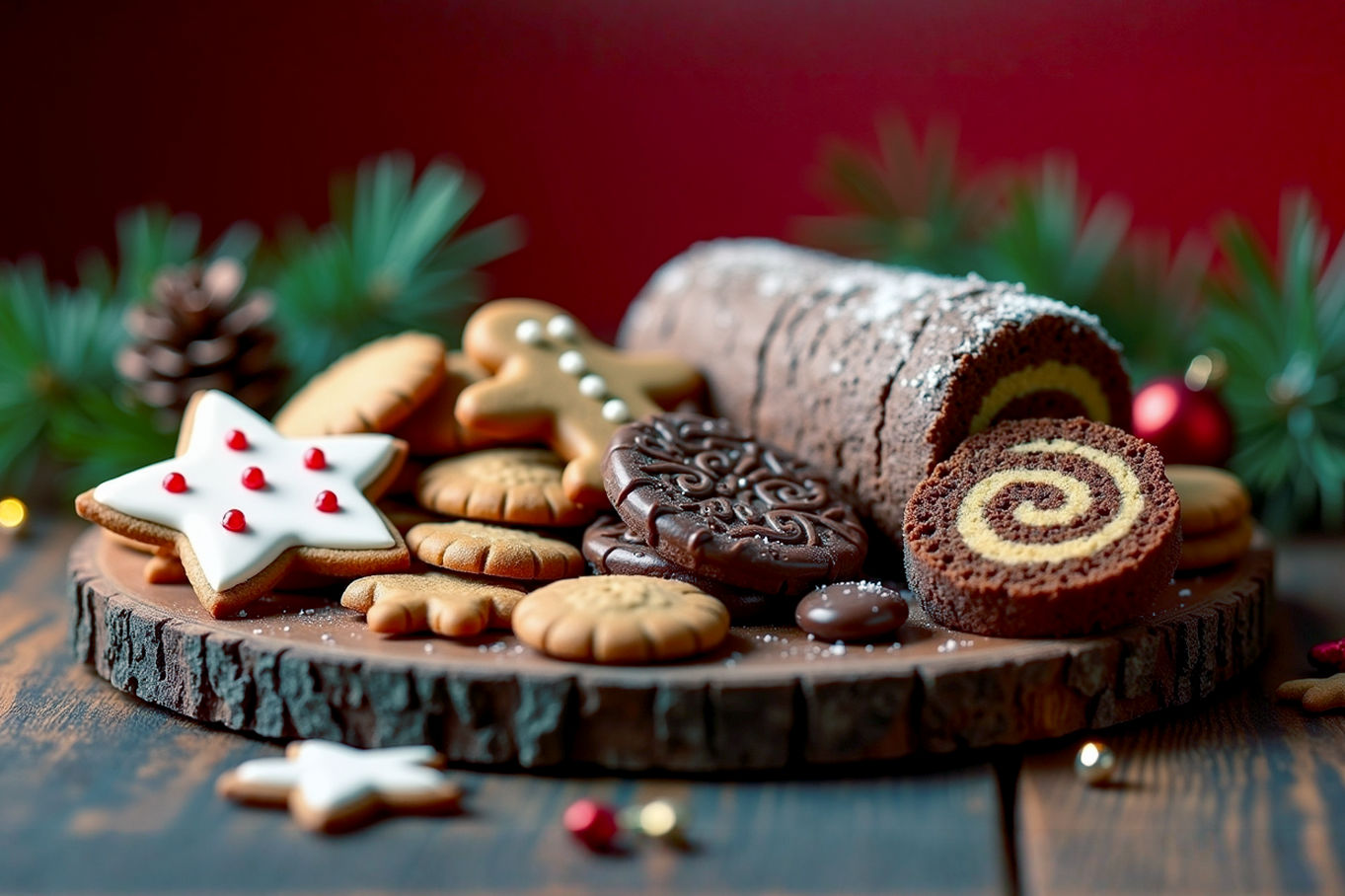This post may contain affiliate links. If you make a purchase through these links, we may earn a commission at no additional cost to you.
Christmas Eve isn’t just the night before the big day; it’s a special occasion filled with anticipation, warmth, and often, cherished culinary traditions. While Christmas Day often features a grand feast, Christmas Eve dinner holds its own unique charm. It’s a time for families to gather, reflect, and enjoy a memorable meal before the excitement of Christmas morning.
This guide will help you understand the rich history behind these traditions and provide you with a comprehensive roadmap to recreate a truly traditional Christmas Eve dinner right in your own home, no matter your background or culinary skill level. We’ll explore diverse customs, offer delicious recipe ideas, and share practical tips for planning and execution, ensuring your Christmas Eve is as magical as the season itself.
Unpacking Christmas Eve Dinner Traditions: A Global Perspective
The concept of a “traditional” Christmas Eve dinner varies significantly across cultures and even within families. These differences often stem from historical, religious, and regional influences. Understanding these diverse traditions can inspire your own celebration, allowing you to either embrace a specific cultural feast or blend elements to create a unique family custom.
The Feast of the Seven Fishes: An Italian-American Legacy
For many Italian-American families, Christmas Eve is synonymous with the Feast of the Seven Fishes, or Festa dei Sette Pesci. This elaborate, meatless meal is a deeply rooted tradition that honors the Catholic custom of abstaining from meat on the vigil of a major feast day. The number seven is symbolic, often linked to the seven sacraments, the seven virtues, or the seven days of creation.
Historically, this tradition emerged from Southern Italy, where fish was a readily available and economical protein. Immigrants brought this custom to America, where it evolved into the grand multi-course seafood spectacle we know today. The dishes typically include a variety of preparations, from fried to baked, stewed, and raw. Common seafood choices range from baccalà (salted cod) and fried calamari to baked clams, shrimp scampi, linguine with clam sauce, and grilled octopus. The meal is a marathon, not a sprint, often lasting for hours as family members share food, stories, and laughter. It’s a testament to abundance and family connection, emphasizing the communal joy of the holiday.
European Variations: Meat, Fish, and Festive Spreads
Beyond Italy, other European countries have distinct Christmas Eve dining customs.
Central and Eastern European Traditions
In many Central and Eastern European nations, such as Poland, the Czech Republic, and parts of Germany, Christmas Eve (often called Wigilia in Poland) is a day of fasting followed by a meatless supper. This meal typically begins after the first star appears in the evening sky, symbolizing the Star of Bethlehem. The dishes are often simple yet symbolic, reflecting the region’s agricultural heritage.
- Poland (Wigilia): The Polish Wigilia is a solemn yet joyous affair, featuring twelve meatless dishes representing the twelve apostles. Key dishes often include:
- Borscht: A clear beetroot soup, sometimes with small mushroom dumplings (uszka).
- Fried Carp: A traditional main course, often prepared simply.
- Pierogi: Dumplings filled with sauerkraut and mushrooms or potatoes and cheese.
- Herring: Prepared in various ways, such as pickled or in cream sauce.
- Kutia: A sweet wheat berry pudding with poppy seeds, honey, and nuts, symbolizing prosperity.
- Kompot z Suszu: A dried fruit compote. The meal often starts with sharing opłatek, a blessed wafer, and exchanging good wishes.
- Germany: In some parts of Germany, Christmas Eve dinner is a simpler meal, often consisting of sausages (like Bockwurst or Wiener) and potato salad, to contrast with the more elaborate Christmas Day feast. However, other regions might feature roasted goose or carp. The focus is often on cozy, comforting fare.
Scandinavian Christmas Eve Feasts
In Scandinavian countries like Sweden and Norway, Christmas Eve is often the main day for celebration and feasting.
- Sweden (Julbord): The Swedish Julbord is a lavish buffet featuring a wide array of hot and cold dishes. While elements might carry over to Christmas Day, a significant portion is enjoyed on Christmas Eve. Essential components include:
- Pickled Herring: A cornerstone, served in various marinades.
- Gravlax or Smoked Salmon: Cured or smoked fish.
- Jansson’s Temptation: A creamy potato gratin with anchovies.
- Meatballs (Köttbullar): Small, savory meatballs.
- Prinskorv: Small sausages.
- Ribbe (Pork Ribs) or Lutefisk: Depending on regional preference.
- Christmas Ham: Often glazed. The Julbord is designed for grazing and communal enjoyment, with multiple rounds of food.
British and American Adaptations
In Britain and America, Christmas Eve dinner traditions are less rigidly defined than in some European countries. While Christmas Day is the primary focus for a grand roast (typically turkey or ham), Christmas Eve often serves as a more relaxed prelude.
- United Kingdom: Many British families opt for a simpler, less formal meal on Christmas Eve, such as a hearty fish pie, lasagna, or even a takeaway. Some might enjoy a traditional pub meal. However, the influence of European traditions is growing, with more families exploring fish-based meals or other festive but less demanding dishes. Roast chicken or gammon can also feature.
- United States: American Christmas Eve dinners are a melting pot of traditions. Families with European heritage often maintain their ancestral customs (like the Feast of the Seven Fishes). Others might have a casual family meal, a special “comfort food” dinner like chili or fondue, or a lighter meal to save appetite for Christmas Day. Roast beef, ham, or even a special pasta dish are popular choices. The emphasis is often on spending quality time together rather than adhering to a strict menu.
Understanding these diverse traditions highlights that “traditional” is a flexible term. It’s about creating meaningful culinary experiences that resonate with your family, whether through ancestral customs or newly formed rituals.
Crafting Your Traditional Christmas Eve Menu: Appetizers to Desserts
Creating a traditional Christmas Eve dinner at home involves more than just cooking; it’s about curating an experience. Your menu should reflect the spirit of the season and your chosen traditions. Here, we’ll break down a comprehensive menu, offering ideas for each course, from tantalizing appetizers to decadent desserts.
Appetizers: Setting the Festive Tone
Appetizers are the opening act of your Christmas Eve feast, designed to whet appetites and encourage mingling. They should be flavorful, visually appealing, and ideally, easy to prepare or make ahead, reducing last-minute stress.
Classic & Elegant Starters
- Smoked Salmon Blinis with Dill and Crème Fraîche: These elegant bites are a staple for a reason. Miniature blinis (small Russian pancakes) provide a soft base for thinly sliced smoked salmon, a dollop of tangy crème fraîche, and a sprinkle of fresh dill. The combination of rich, savory salmon with creamy, zesty dairy and herbaceous freshness is a delightful start. You can buy pre-made blinis to save time.
- Shrimp Cocktail: A timeless classic, shrimp cocktail offers a refreshing and sophisticated beginning. Large, perfectly cooked shrimp are served chilled with a zesty, horseradish-spiked cocktail sauce. The key is to use high-quality shrimp and ensure the sauce has a good balance of tang and heat. It’s simple to assemble but always impressive.
- Baked Brie in Puff Pastry: This warm, gooey appetizer is a crowd-pleaser. A wheel of Brie cheese is wrapped in puff pastry, often with a topping like cranberry sauce, fig jam, or toasted nuts, then baked until golden and bubbly. The flaky pastry exterior gives way to a molten, savory cheese interior. It’s rich, comforting, and perfect for sharing.
Hearty & Comforting Bites
- Miniature Meatballs (Cocktail Meatballs): Whether simmered in a sweet and sour sauce, a cranberry glaze, or a savory mushroom gravy, cocktail meatballs are a comforting and satisfying appetizer. They can be made ahead and kept warm in a slow cooker, making them ideal for entertaining.
- Stuffed Mushrooms: These savory bites are incredibly versatile. Mushroom caps can be filled with a variety of mixtures, such as a breadcrumb, herb, and cheese stuffing; a sausage and fennel mixture; or a creamy spinach and artichoke blend. They offer a hearty, earthy flavor and are perfect for a more substantial appetizer.
- Pigs in a Blanket: A nostalgic favorite, pigs in a blanket are small sausages or hot dogs wrapped in crescent roll dough and baked until golden. They’re easy to make and universally loved, especially by younger guests. For a gourmet twist, use higher-quality sausages and a sprinkle of everything bagel seasoning.
Main Courses: The Heart of the Feast
The main course is the centerpiece of your Christmas Eve dinner, reflecting the chosen tradition. Whether you opt for a fish-centric meal or a hearty meat dish, quality ingredients and careful preparation are key.
Fish-Focused Mains (Inspired by Feast of the Seven Fishes)
If you’re leaning into the Feast of the Seven Fishes tradition, variety in preparation and type of fish is crucial.
- Baccalà (Salted Cod): This is a cornerstone of Italian Christmas Eve. Salted cod needs to be rehydrated for several days, but its firm, flaky texture and rich flavor are worth the effort. It can be prepared in various ways:
- Baccalà Fritto: Simply floured and fried until golden and crispy.
- Baccalà in Umido: Stewed with tomatoes, olives, capers, and herbs, creating a savory, comforting dish.
- Baccalà con Patate: Baked with potatoes, onions, and olive oil.
- Linguine with Clam Sauce (Linguine alle Vongole): A classic pasta dish, this features tender clams (fresh or canned) simmered in a delicate white wine, garlic, and olive oil sauce, often with a hint of red pepper flakes. The sauce coats the pasta beautifully, offering a light yet satisfying main.
- Baked Whole Salmon or Salmon en Croûte: For a show-stopping fish dish, a whole roasted salmon, perhaps stuffed with herbs and lemon, makes a stunning centerpiece. Alternatively, Salmon en Croûte (salmon wrapped in puff pastry with a savory filling like spinach and cream cheese) is elegant and impressive. The pastry creates a moist environment for the fish and a beautiful golden crust.
- Fried Calamari: Lightly breaded and quickly fried squid rings are a popular and delicious addition to a seafood spread. Serve with lemon wedges and marinara sauce for dipping. The key is to fry them quickly at a high temperature to ensure they’re tender, not rubbery.
Meat-Focused Mains (For Other Traditions)
For those whose traditions lean towards meat, there are equally festive and delicious options.
- Roast Beef Tenderloin: An incredibly tender and luxurious cut of beef, a roasted beef tenderloin is perfect for a special occasion. It cooks relatively quickly and can be served with a rich red wine reduction or a creamy horseradish sauce. Its mild flavor allows it to pair well with various side dishes.
- Glazed Ham: A spiral-cut or bone-in ham with a sweet and savory glaze (like brown sugar and mustard, or orange and clove) is a classic choice. It’s often easier to prepare than a full turkey and can feed a crowd. Plus, leftovers are fantastic for sandwiches.
- Roasted Duck: For a smaller, more intimate gathering, a whole roasted duck offers a rich, flavorful alternative to turkey or ham. Its crispy skin and succulent dark meat are a true treat. Duck pairs wonderfully with fruit-based sauces, such as cherry or orange.
- Lasagna or Baked Ziti: In some traditions, especially where a large, comforting dish is preferred, a hearty lasagna or baked ziti can be the main event. These pasta bakes are excellent make-ahead options, allowing flavors to meld and reducing last-minute cooking. They are substantial and satisfying, perfect for a family gathering.
Side Dishes: Complementing the Main Event
Side dishes are essential for a balanced and flavorful Christmas Eve dinner. They add texture, color, and additional layers of taste, complementing your chosen main course.
- Roasted Potatoes: Crispy on the outside and fluffy on the inside, roasted potatoes are a universal favorite. Tossed with olive oil, rosemary, and garlic, they provide a comforting and essential starch.
- Green Bean Almondine: A simple yet elegant side, green beans are blanched until tender-crisp and then sautéed with toasted slivered almonds and a touch of butter. The nutty crunch and vibrant green color make it a refreshing addition.
- Glazed Carrots: Sweet and tender, glazed carrots (with butter, brown sugar, or maple syrup) add a touch of sweetness and a beautiful orange hue to the plate.
- Creamed Spinach: Rich and decadent, creamed spinach provides a creamy, savory counterpoint to roasted meats or fish. It’s a comforting classic that adds a touch of indulgence.
- Braised Red Cabbage: Especially popular in German traditions, braised red cabbage offers a sweet and sour tang that cuts through richer dishes. Cooked slowly with apples, vinegar, and spices, it develops a deep, complex flavor.
Desserts: A Sweet Ending to a Festive Night
Dessert is the grand finale, a sweet conclusion to your Christmas Eve feast. These treats should be festive, comforting, and perhaps even nostalgic.
- Panettone or Pandoro: These Italian sweet breads are quintessential Christmas treats. Panettone is a dome-shaped bread filled with candied fruits and raisins, while Pandoro is a star-shaped, plain sweet bread often dusted with powdered sugar. Both are light, airy, and perfect for slicing and serving with coffee or a glass of dessert wine.
- Tiramisu: This classic Italian dessert, meaning “pick me up,” features layers of coffee-soaked ladyfingers, mascarpone cheese cream, and cocoa powder. It’s rich, creamy, and has a wonderful balance of bitter coffee and sweet cream. It can be made ahead, allowing flavors to deepen.
- Yule Log (Bûche de Noël): A decorative and delicious rolled sponge cake, typically flavored with chocolate and frosted to resemble a log. It’s a festive centerpiece that’s surprisingly fun to make (or buy!).
- Christmas Cookies: A platter of assorted Christmas cookies (gingerbread, sugar cookies, shortbread) offers variety and a chance for guests to pick their favorites. They’re also perfect for leaving out for Santa!
- Fruit Tart or Pavlova: For a lighter, brighter dessert, a fresh fruit tart or a Pavlova (a meringue-based dessert with a crisp crust and soft, light interior, topped with whipped cream and fresh fruit) offers a refreshing contrast to heavier meal components.
Planning and Preparation: Ensuring a Smooth Christmas Eve Dinner
A successful Christmas Eve dinner relies heavily on thoughtful planning and strategic preparation. By breaking down tasks and utilizing smart techniques, you can minimize stress and maximize enjoyment.
The Importance of Early Planning
Starting your planning early is the single most effective way to ensure a smooth Christmas Eve dinner. Don’t wait until the last minute!
- Guest List and Dietary Needs (4-6 Weeks Out): Begin by finalizing your guest list. This will determine quantities and help you identify any dietary restrictions or allergies (vegetarian, vegan, gluten-free, nut allergies, etc.). Knowing these early allows you to plan alternative dishes or modifications without last-minute scrambling.
- Menu Selection (3-4 Weeks Out): With your guest count and dietary needs in mind, finalize your menu. Consider a balance of flavors, textures, and cooking methods. Aim for a mix of dishes that can be made ahead, those that require minimal last-minute attention, and perhaps one show-stopping item that needs fresh preparation.
- Recipe Sourcing and Ingredient List (2-3 Weeks Out): Once the menu is set, gather all your recipes. Read through each one carefully, noting ingredients and equipment needed. Create a master shopping list, categorizing items by grocery store section (produce, dairy, pantry, meat/fish). This prevents multiple trips to the store.
- Equipment Check (2 Weeks Out): Ensure you have all the necessary cookware, bakeware, serving dishes, and utensils. Do you have enough plates, glasses, and cutlery? If not, plan to borrow or purchase what you need. Check if your oven and stovetop are in good working order.
Strategic Food Preparation: The Make-Ahead Advantage
Maximizing make-ahead components is crucial for reducing stress on Christmas Eve. Many dishes can be prepared partially or entirely in advance.
- Freezer-Friendly Items (Weeks Ahead):
- Stocks and Sauces: Homemade chicken, beef, or vegetable stocks can be made and frozen. Many sauces (like a basic marinara for pasta dishes or a gravy base) also freeze well.
- Certain Appetizers: Mini meatballs can be cooked and frozen. Some stuffed mushrooms can be assembled and frozen unbaked.
- Desserts: Cookie dough can be frozen and baked fresh. Components of a tiramisu (like the coffee-soaked ladyfingers) can be prepared, or the entire dessert can be assembled and frozen (though texture may vary slightly upon thawing).
- Refrigerate-Ahead Items (Days Ahead):
- Vegetable Prep: Chop onions, garlic, carrots, celery, and other vegetables. Store them in airtight containers in the refrigerator. This saves significant time on the day of the dinner.
- Sauces and Dressings: Prepare salad dressings, dipping sauces (like cocktail sauce), and any other cold sauces.
- Dough Preparation: If making homemade pasta or pastry, prepare the dough and refrigerate it.
- Dessert Assembly: Tiramisu, cheesecakes, and many puddings benefit from being made a day or two in advance, allowing flavors to meld and textures to set.
- Brining Meats: If you’re brining a ham or poultry, start this process a day or two before.
- The Day Before (Christmas Eve Eve):
- Partial Cooking: Roast vegetables that can be reheated. Par-cook potatoes for roasting on Christmas Eve.
- Table Setting: Set the dinner table the day before. This frees up valuable time on Christmas Eve and allows you to enjoy the festive ambiance.
- Beverage Prep: Chill wines, make ice, and prepare any non-alcoholic drinks or cocktail mixers.
- Defrosting: Ensure any frozen items are moved to the refrigerator to defrost thoroughly. Large items like a whole turkey or ham can take several days to defrost safely.
Creating a Detailed Timeline
A timeline is your best friend for managing Christmas Eve dinner. Work backward from your desired serving time.
- Morning of Christmas Eve:
- Take out any ingredients that need to come to room temperature (e.g., butter, eggs, certain meats).
- Prepare any fresh salads or delicate components.
- Start cooking dishes with long cooking times (e.g., braised meats, large roasts).
- Begin final assembly of make-ahead dishes.
- Early Afternoon:
- Preheat oven.
- Start roasting or baking main courses and sides that require significant oven time.
- Prepare any last-minute sauces or garnishes.
- 1-2 Hours Before Dinner:
- Cook any quick-cooking items (e.g., pan-seared fish, delicate vegetables).
- Reheat make-ahead dishes.
- Finalize appetizers and arrange them for serving.
- Put out drinks.
- Just Before Serving:
- Carve meats if necessary.
- Plate appetizers or arrange them on platters.
- Bring all dishes to the table simultaneously.
- Light candles and dim lights for ambiance.
By meticulously planning and leveraging make-ahead strategies, you can transform the potential chaos of Christmas Eve cooking into a calm and enjoyable experience, allowing you to truly savor the moments with your loved ones.
Ambiance and Atmosphere: Setting the Christmas Eve Scene
The food is undeniably central to a traditional Christmas Eve dinner, but the ambiance and atmosphere are what truly elevate the experience from a meal to a cherished memory. Creating a festive and welcoming environment enhances the joy and warmth of the occasion.
Table Setting: A Feast for the Eyes
Your Christmas Eve table setting is a canvas for holiday cheer. It doesn’t have to be overly elaborate, but thoughtful touches can make a significant impact.
- Linens: Start with a clean, pressed tablecloth, perhaps in a festive color like deep red, forest green, gold, or classic white. Add placemats for individual settings.
- Dinnerware and Glassware: Use your best china or special holiday plates. Mix and match patterns for an eclectic, charming look if you prefer. Ensure you have appropriate glassware for water, wine, and any other beverages.
- Cutlery: Polish your silverware or use festive gold/copper cutlery. Arrange it according to standard etiquette or in a way that feels natural and inviting.
- Centerpiece: A beautiful centerpiece anchors the table. Consider:
- Natural Elements: Pine boughs, holly, cranberries, cinnamon sticks, and oranges create a wonderful aroma and rustic charm.
- Candles: Pillar candles of varying heights or elegant taper candles cast a warm, inviting glow. Always ensure they are placed safely away from flammable decorations.
- Ornaments: Scatter a few festive ornaments or small baubles around the centerpiece for sparkle.
- Flowers: A simple arrangement of seasonal flowers like amaryllis, paperwhites, or poinsettias adds elegance.
- Personal Touches:
- Name Cards: Hand-written name cards add a personal touch and help guests find their seats.
- Napkins: Fold cloth napkins creatively (e.g., a fan fold, a Christmas tree shape) and secure with a festive napkin ring or a sprig of rosemary.
- Small Favors: A tiny wrapped candy, a personalized ornament, or a handwritten note at each place setting can be a delightful surprise.
Lighting: Creating a Warm Glow
Lighting plays a crucial role in setting the mood.
- Dimmed Overhead Lights: Avoid harsh overhead lighting. Instead, dim your main lights to create a softer, more intimate atmosphere.
- Candlelight: As mentioned, candles are essential for warmth and glow. Use them generously on the dining table, sideboards, and even in other areas of the room.
- Fairy Lights/Twinkle Lights: Drape strings of warm white fairy lights around windows, doorways, or even as part of your table runner. Their gentle twinkle adds a magical, ethereal quality.
- Fireplace: If you have a fireplace, light a fire. The crackling sounds and dancing flames instantly create a cozy, traditional Christmas ambiance.
Music: The Soundtrack of the Season
Music is a powerful tool for setting the festive mood.
- Classic Christmas Carols: A playlist of traditional Christmas carols (instrumental or vocal) evokes a sense of nostalgia and tradition.
- Instrumental Holiday Music: For background ambiance, instrumental holiday jazz, classical arrangements, or orchestral Christmas music can provide a sophisticated yet festive soundtrack without being distracting.
- Variety: Mix in some contemporary holiday hits to keep the mood lively, but ensure the overall tone remains warm and inviting.
Scents: Aromatic Delights
Our sense of smell is strongly linked to memory and emotion. Infuse your home with festive aromas.
- Simmer Pot: Create a natural diffuser by simmering a pot of water with orange slices, cinnamon sticks, cloves, star anise, and fresh cranberries on the stovetop.
- Pine and Evergreen: If you have a real Christmas tree, its natural scent will fill the air. Otherwise, incorporate pine boughs or evergreen garlands into your decorations.
- Baking Aromas: The smell of freshly baked cookies, gingerbread, or a roasting ham will naturally contribute to the festive atmosphere.
By paying attention to these details – from the visual appeal of your table to the subtle scents and sounds – you can transform your home into a truly enchanting setting for a traditional Christmas Eve dinner, making it an unforgettable experience for everyone.
Beverages: Toasting the Season
No festive meal is complete without a selection of beverages to complement the food and elevate the celebratory mood. From elegant cocktails to comforting non-alcoholic options, your drink menu should cater to all tastes and ages, adding to the overall Christmas Eve experience.
Festive Alcoholic Beverages
For adults, a well-chosen alcoholic beverage can enhance the flavors of the meal and add to the festive cheer.
- Wine Pairings:
- For Fish-Focused Meals (Feast of the Seven Fishes): Opt for crisp, dry white wines.
- Pinot Grigio: Light-bodied with bright acidity, it pairs beautifully with delicate white fish, shrimp, and clam sauces. Its subtle citrus notes won’t overpower the seafood.
- Sauvignon Blanc: Known for its vibrant acidity and herbaceous notes, it complements richer fish like salmon or dishes with stronger flavors like capers or olives.
- Vermentino or Greco di Tufo: If leaning into Italian traditions, these Italian white wines offer excellent minerality and a refreshing character that stands up to various seafood preparations.
- For Meat-Focused Meals (Ham, Beef, Duck):
- Pinot Noir: A versatile red wine, its lighter body and red fruit notes pair well with ham, duck, and even lighter beef dishes. It’s less tannic than heavier reds, making it approachable.
- Merlot: A medium-bodied red with soft tannins, Merlot is a good choice for roasted ham or beef tenderloin, offering dark fruit flavors and a smooth finish.
- Chianti or Sangiovese: If serving lasagna or a hearty pasta dish, a classic Italian red like Chianti provides the necessary acidity and savory notes to cut through the richness.
- For Fish-Focused Meals (Feast of the Seven Fishes): Opt for crisp, dry white wines.
- Sparkling Wine/Prosecco: A bottle of sparkling wine or Prosecco is perfect for a celebratory toast. Its effervescence and crispness can also act as a palate cleanser between courses, especially with a multi-course meal like the Feast of the Seven Fishes.
- Christmas Cocktails:
- Eggnog (Spiked or Unspiked): A quintessential holiday drink, eggnog can be made with rum, brandy, or bourbon for a rich, creamy, and warming beverage.
- Mulled Wine: Aromatic and comforting, mulled wine is red wine gently heated with spices like cinnamon, cloves, star anise, and citrus peels. It fills the home with a wonderful aroma and is perfect for a chilly evening.
- Cranberry Mimosas or Poinsettia Cocktails: For a lighter, brighter option, combine cranberry juice with Prosecco or Champagne. These are festive, easy to make, and visually appealing.
- Winter Sangria: A red wine sangria infused with seasonal fruits (apples, cranberries, oranges) and spices, often with a splash of brandy or orange liqueur. It’s a great make-ahead option for a crowd.
Delightful Non-Alcoholic Options
It’s important to offer equally appealing non-alcoholic options for children, designated drivers, and those who prefer not to drink alcohol.
- Sparkling Cider or Grape Juice: A festive alternative to sparkling wine, these offer a celebratory fizz without the alcohol.
- Hot Cocoa Bar: A fun and interactive option, especially for families with children. Set up mugs, hot cocoa mix, whipped cream, marshmallows, chocolate shavings, and candy canes.
- Christmas Punch: Create a vibrant, flavorful punch with fruit juices (cranberry, apple, orange), ginger ale or sparkling water, and garnishes like fresh cranberries, orange slices, and rosemary sprigs.
- Spiced Apple Cider: Warm apple cider infused with cinnamon sticks, cloves, and a touch of orange peel is incredibly comforting and aromatic.
- Festive Mocktails: Adapt popular cocktail recipes into mocktails using non-alcoholic spirits, flavored syrups, and fresh fruit. For example, a “No-jito” with mint, lime, and sparkling water, or a “Cranberry Sparkler” with cranberry juice, lime, and ginger beer.
Remember to have plenty of water available, perhaps infused with cucumber, mint, or citrus slices for a refreshing touch. Offering a diverse range of beverages ensures that every guest feels included and can enjoy a drink that perfectly complements the festive spirit of your Christmas Eve dinner.
Post-Dinner Delights and Traditions: Extending the Magic
The Christmas Eve dinner doesn’t have to end when the last bite of dessert is savored. Many families extend the magic with post-dinner activities and cherished traditions that create lasting memories and build anticipation for Christmas Day.
Relaxed Conversation and Board Games
After a substantial meal, there’s nothing quite like settling in for relaxed conversation. Encourage guests to linger at the table or move to a comfortable living area.
- Storytelling: This is a perfect time for sharing family stories, especially those related to past Christmases or holiday memories. Grandparents or older family members can recount tales, connecting generations.
- Board Games or Card Games: A friendly game of charades, Pictionary, or a classic board game can provide lighthearted entertainment and encourage interaction. Keep it low-key and fun, focusing on participation rather than intense competition.
- Christmas Puzzles: Setting up a large Christmas-themed jigsaw puzzle on a side table can be a quiet, collaborative activity that guests can dip in and out of throughout the evening.
Traditional Activities and Entertainment
Many families have specific rituals they follow on Christmas Eve. These traditions often center around storytelling, music, or preparing for Santa’s arrival.
- Reading Christmas Stories: Gather everyone, especially children, for a reading of classic Christmas stories like “’Twas the Night Before Christmas” or “A Christmas Carol.” This creates a cozy, nostalgic atmosphere.
- Christmas Caroling (Indoors or Out): If weather permits and you have an enthusiastic group, consider a short session of outdoor caroling for neighbors. Alternatively, an indoor sing-along to favorite Christmas songs can be just as joyful.
- Watching Christmas Movies: A beloved Christmas movie (e.g., It’s a Wonderful Life, A Christmas Story, Elf) can be a comforting way to wind down the evening. Choose a film that appeals to all ages present.
- Leaving Treats for Santa and Reindeer: This is a magical tradition for children. Help them leave out milk and cookies for Santa Claus and carrots for his reindeer. This simple act builds excitement and wonder.
- Opening One Gift (Optional): Some families have a tradition of opening one small gift on Christmas Eve. This could be new pajamas, a book, or a small toy, adding a little extra sparkle to the evening without diminishing the excitement of Christmas morning.
Attending Midnight Mass or Christmas Eve Service
For many, Christmas Eve holds deep religious significance.
- Midnight Mass/Christmas Eve Service: Attending a late-night church service or Midnight Mass is a spiritual tradition for many Christian families. It’s a time for reflection, prayer, and communal celebration of the birth of Jesus. If attending, factor in travel time and dress code.
- Candlelight Service: Some churches offer earlier candlelight services that are family-friendly, providing a beautiful and solemn way to mark the occasion.
Preparing for Christmas Morning
Even amidst the festivities, some practical preparations for Christmas morning are often part of the Christmas Eve routine.
- Stocking Stuffing: While children are asleep (or occupied), adults often take this time to fill stockings.
- Last-Minute Gift Wrapping: If any gifts remain unwrapped, Christmas Eve night is often the time for this final task.
- Setting Out Gifts: Once children are in bed, gifts are often placed under the tree, ready for the morning’s excitement.
By incorporating these post-dinner delights and traditions, you extend the warmth and joy of Christmas Eve, creating a holistic and memorable experience that truly captures the spirit of the holiday season. These moments, often simple yet profound, are what families remember and cherish for years to come.
Troubleshooting and Tips for a Stress-Free Christmas Eve
Even with the best planning, hosting a traditional Christmas Eve dinner can present challenges. Knowing how to troubleshoot common issues and implementing smart strategies can help ensure your evening is as stress-free and enjoyable as possible.
Common Challenges and Solutions
- Overwhelm and Time Crunch:
- Challenge: Feeling like there’s too much to do and not enough time.
- Solution: Prioritize and delegate. Not every dish has to be homemade. Don’t be afraid to purchase high-quality pre-made items (e.g., a good quality lasagna, pre-made blinis, store-bought desserts). Delegate tasks to family members or guests. Assign specific roles: one person on appetizers, another on drinks, someone else on table setting.
- Solution: Embrace the timeline. Stick to your detailed preparation schedule. If something falls behind, adjust expectations. A slightly less perfect dish is better than a stressed host.
- Dietary Restrictions:
- Challenge: Catering to various dietary needs without making separate meals.
- Solution: Focus on naturally compliant dishes. Many vegetable sides can be made vegan or gluten-free with minor adjustments. Offer a main dish that can be easily adapted (e.g., a simple roasted fish for gluten-free/dairy-free guests, or a hearty vegetable stew for vegetarians). Clearly label dishes.
- Solution: Communicate with guests. Ask them about their needs in advance and discuss what you plan to serve. They might offer to bring a dish that suits their requirements.
- Kitchen Space and Oven Juggling:
- Challenge: Limited oven space or stovetop burners, especially for a multi-course meal.
- Solution: Plan dishes with varied cooking methods. Include items that can be served cold (appetizers, salads), cooked on the stovetop, made in a slow cooker, or prepared ahead and reheated.
- Solution: Stagger cooking times. If multiple dishes need the oven, plan their cooking temperatures and times so they can be rotated efficiently. Use warming drawers or low oven settings to keep dishes hot.
- Unexpected Guests or Changes:
- Challenge: Last-minute additions to the guest list or unforeseen changes.
- Solution: Always have a backup plan or adaptable ingredients. Keep extra pasta, a frozen lasagna, or ingredients for a quick salad on hand. A large pot of soup or a simple roasted chicken can be scaled up easily.
- Solution: Be flexible. The spirit of Christmas Eve is about togetherness. A slightly less formal meal is perfectly fine if it means accommodating more loved ones.
Smart Tips for a Smoother Experience
- Mise en Place (Everything in its Place): Before you start cooking, gather all your ingredients, measure them out, and have all your tools ready. This professional kitchen technique significantly reduces stress and errors during cooking. Chop all vegetables, measure spices, and prepare sauces in advance.
- Clean as You Go: Don’t let dirty dishes pile up. Wash pots, pans, and utensils as you use them. This makes post-dinner cleanup much less daunting. Enlist family members to help with this.
- Set the Table Early: As mentioned, setting the table the day before is a huge time-saver and allows you to enjoy the festive decor longer.
- Create a Relaxed Atmosphere: Remember, the goal is to enjoy the evening. Don’t strive for perfection. A relaxed host makes for relaxed guests. If something goes wrong, laugh it off.
- Delegate and Accept Help: Don’t be a martyr. If guests offer to bring something or help in the kitchen, accept! It makes them feel useful and lightens your load.
- Don’t Forget the Drinks: Ensure drinks are chilled, ice is plentiful, and glasses are ready. A self-serve drink station can free you up.
- Plan for Leftovers: Have containers ready for leftovers. Many Christmas Eve dishes taste even better the next day, providing easy meals during the busy holiday week.
- Enjoy the Process: Remind yourself why you’re doing this – to create cherished memories with loved ones. Focus on the joy of the gathering, not just the food.
By anticipating potential hurdles and employing these practical tips, you can transform the often-stressful task of hosting a traditional Christmas Eve dinner into a truly enjoyable and memorable occasion, allowing you to fully immerse yourself in the festive spirit.
Conclusion: Cherishing Your Homemade Christmas Eve Tradition
Recreating a traditional Christmas Eve dinner at home is more than just preparing a meal; it’s an act of love, a continuation of heritage, and an opportunity to forge new, cherished memories. Whether you embrace the elaborate seafood feast of the Feast of the Seven Fishes, the comforting simplicity of a European meatless supper, or a blend of traditions that resonate with your own family, the essence lies in the shared experience.
From the meticulous planning and strategic make-ahead preparations to the thoughtful setting of the table and the careful selection of beverages, every detail contributes to the magic. The aromas wafting from the kitchen, the soft glow of candlelight, the festive music, and the laughter of loved ones all weave together to create an atmosphere of warmth and anticipation.
As you gather around your beautifully set table, remember that the true spirit of Christmas Eve isn’t found in culinary perfection, but in the connection, gratitude, and joy shared among family and friends. These are the moments that truly define the holiday season – the quiet, intimate prelude to the grand celebration, filled with traditions that bind us and memories that last a lifetime. May your homemade Christmas Eve dinner be a source of warmth, happiness, and enduring tradition for years to come.

